 USA menu USA menu
————- Section B ————- ————- Section C ————- ————- Section D ————- ————- Section E ————-
|

Chapter VII / Section D
Polyrhythms
Emo–Intellectual
Energies Combined
Emo–Intellectual Effect can be seen when the both Emotional and Intellectual Cycles unite. In an Physo–Intellectual High, for example, market speculation could enhance business expansion. During an Emotional High – Intellectual Low, forms of simple entertainment might replace reading. In an Emotional Low – Intellectual High, religious dogma might lose ground to scientific claims. An Emo–Intellectual Low might spawn apathy and short attention spans.
top (of Section C)
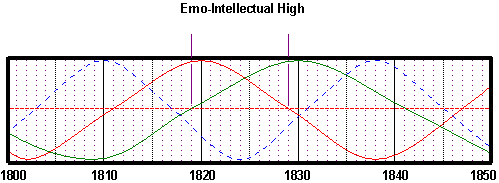
We had an Emo–Intellectual High from 1819 – 1829. Women and religion rose with the Emotional Cycle in the 1820s. Publication and education rose with the Intellectual Cycle. These combined as Emma Willard founded America’s first collegiate level school for women in 1821, the Troy Female Seminary in New York. The American Sunday School Union began in Philadelphia in 1824 to promote and coordinate Sunday schools. Landmark literature emerged such as Timothy Dwight’s “Travels in New England and New York” in four volumes, James Fenimore Cooper’s Leatherstocking Tales with the “The Last of the Mohicans,” still popular today, and Edgar Allen Poe’s first book of poems. Arts increased in publications, music schools increased, and the Hudson River School of landscape painting began in the
Emo-Intellectual High.

We had an Emo-Intellectual Low from 1841 – 1847. The world of literature changed while both Cycles were Low. As the Emotional Cycle switched from High to Low, tastes shifted from idealism to prosaic realism and darker styles. Epitomizing the dark literary form, and even the macabre, was Edgar Allen Poe. He published “Tales of the Grotesque and Arabesque,” “The Raven and Other Poems,” “A Descent into the Maelstrom,” and “The Murders in the Rue Morgue” during this time. The Intellectual Cycle was also Low and this made success difficult for some creators of America’s finer masterworks. Herman Melville began publishing in 1846 and went on to release his masterpiece, “Moby Dick,” only to find it misunderstood by readers and critics alike during the Intellectual Low. Melville ended his days as a literary unknown working as a custom inspector in New York City. Despite Poe’s popularity with “The Raven,” he became so impoverished that his magazine “Broadway Journal” failed in 1845 after two years of great productivity. “The Dial” is another publication that ended in 1845 after lackluster interest for its sixteen issues produced since 1840. Today “The Dial” is recognized as the most significant documentation of New England Transcendentalism with contributions from remarkable authors like Ralph Waldo Emerson, Henry David Thoreau and more. Its first editor, Margaret Fuller, is also recognized today as one of America’s foremost intellectuals and literary critics of the time. She had knowledge of German, philosophy and was a supporter of women’s rights, but she, and others, found only a limited audience during the Emo-Intellectual Low.

An Emotional High &
Intellectual Low from 1847 – 1863 came to us. Religion was up and the economy was down. As the Emotional Cycle rose in the 1840s and 1850s a religious revival began in New York and Pennsylvania then swept the nation. Every American city had an increase of daily prayer meetings and churches, The Young Men’s Christian Association and The Ladies’ Christian Association founded, and construction began on St. Patrick’s Cathedral in New York City. At the same time, the Intellectual (& Physical) Cycle troughed, bringing turmoil to the economy. The Panic of 1857 and thousands of business failures plagued the nation. A confluence of these energies, however, came with the belief among many people that hope and religion would help them to endure and change the difficult times during an Emotional High and Intellectual Low. This was a view that would come again in many who struggled through the Great Depression that also came with an Emotional High and Intellectual (and Physical) Trough in the 1930s.<
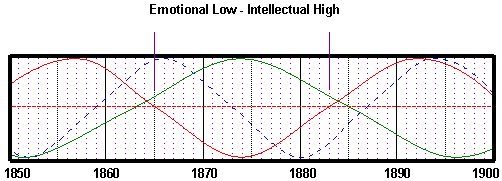
An Emotional Low & Intellectual High from 1865 – 1883 occurred and religion, which is Emotionally-based, yielded some ground to the theory of evolution, which is Intellectually-based. After British naturalist Charles Darwin published “Origin of Species” in 1859, he first met with controversy for departing from creationism with scientific theory. A changing tide in America after 1865, however, brought corroboration for Darwin. John Fiske published “Outlines of Cosmic Philosophy” in 1874 to reconcile Darwin’s views with religion. Theological liberalism became espoused by intellectuals in the Protestant clergy like Henry Ward Beecher, James Freeman Clarke, Philip Brooks and James McCosh, who all conceded that the book of Genesis cannot be taken literally. Others like Abbott, Gladden, Brooks, Draper and White were also willing to counter religious orthodoxy for new observations. Ideas may polarize both religion and science to favor the latter during an Emotional Low and Intellectual High.
top (of Section C)
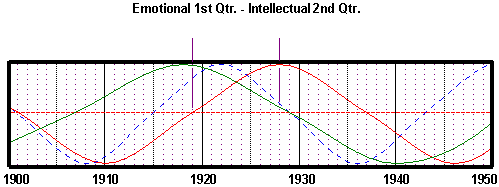
An Emotional 1st Qtr. & Intellectual 2nd Qtr. occured from 1919 – 1928. The Emotional Cycle brings change to women’s issues. An Emotional 1st Qtr. of Foundation and Precedents brouth new rights for women. The Intellectual Cycle influences our thinking and institutions. An Intellectual 2nd Qtr of Variation & Improvement brought change to our policies. The result was to expand voting rights to women. Only men had traditionally been permitted to vote, but when Congress passed the Nineteenth Amendment to the Constitution in 1919, this right expanded to women. The Senate ratified women’s suffrage in time for women to vote in the 1920 presidential election. Susan B. Anthony had originally proposed the amendment in 1869 during an Emotional High, but both the Physical and Intellectual Cycles were Low, and opposed to variation. The bill was reintroduced in 1878 during an Intellectual 2nd Qtr., but the Emotional Cycle was Low. The bill returned in 1919, our first notable Emo-Intellectual High to follow, and suffrage passed, then, the National League of Women Voters began the following year. We also had; our first woman to preside over the House of Reps. in 1921 (Alice Robertson of Oklahoma, for thirty minutes), our first first woman Senator in 1922, (Rebecca L. Felton of Georgia), and our first women as governors in 1925, (Nellie Ross of Wyoming and “Ma” Ferguson of Texas). It came with an Emo-Intellectual High.
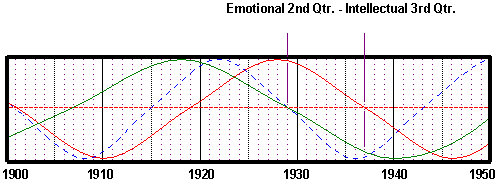
An Emotional 2nd Qtr. & Intellectual 3rd Qtr. occurred from 1929 – 1937. An Emotional 2nd Quarter brings Expansion and Variation. The Emotional High emphasized human rights and the arts. An Intellectual 3rd Quarter brought Review and Reform to past concepts of issues. Both the Dawes Act of 1882 and the Burke Act of 1906 that sought to assimilate Native American Indians into American society were reversed in 1933. Indian Commissioner, John Collier, emphasized revival of tribal arts and craft. Congress passed the Wheeler-Howard Act in 1934 to allow self government to Indians in order to preserve their customs, beliefs and traditions. The expansion and recognition of Indian arts and beliefs came with Emotional 2nd Quarter Variation. Reform of past laws and preservation of tradition came with Intellectual 3rd Quarter Review and Reform.
top (of Section C)
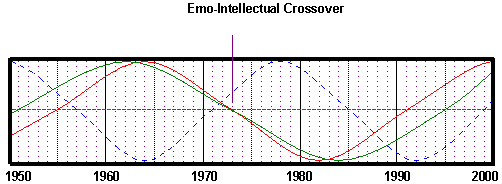
A Double Downward Crossover of the Emotional & Intellectual Cycles happened in 1973. This was a double crisis. The Watergate affair led to the resignation of many members of the Nixon administration including the Vice-President, and ultimately, to the President himself. The economy took a downturn in the “Recession of 1973 – 1974” with
successive quarters of diminished output, falling stock prices and layoffs across the nation. A world wide crisis came in the bloodline of our economy, the American built industry of oil, when the Arab oil embargo left shrinking supplies of increasingly expensive gasoline and motorists piled up in long gas lines. As in 1901 and 1929, a Double Downward Crossover brought double trouble in the transition.
top (of Section C)
[coming soon]
top (of Section D)


